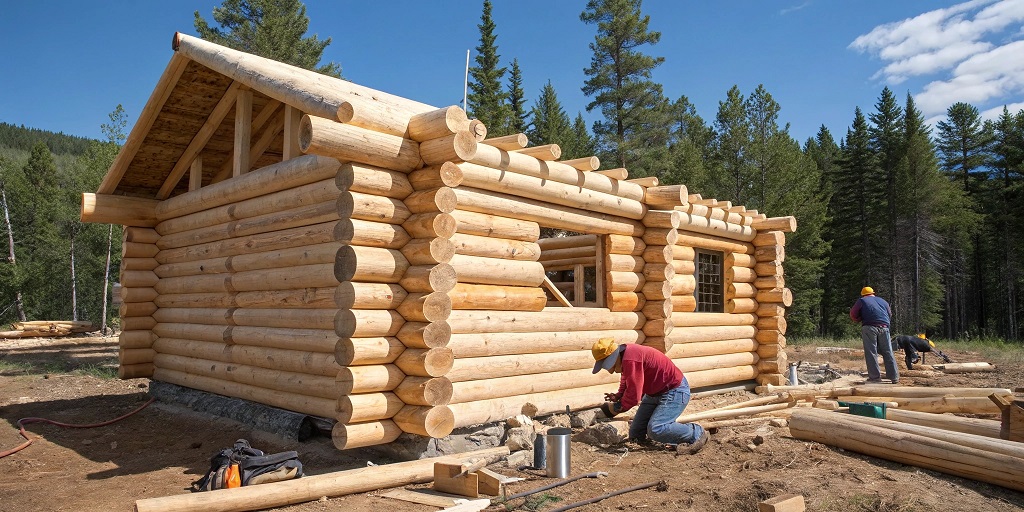Key Takeaways
- Discover the historical roots and enduring appeal of log cabin construction.
- Explore eco-friendly materials and sustainable forestry practices shaping modern log homes.
- Learn essential design choices that enhance both aesthetics and energy efficiency.
- Identify the latest advancements in building technology for log structures.
- Gain insight into the maintenance and preservation of log cabins.
- Read about innovative projects and community spaces inspired by log cabin architecture.
The Enduring Charm of Log Cabins
Few structures capture the imagination quite like a log cabin. These timeless dwellings have provided shelter, security, and warmth for generations, beginning as humble abodes built by hand and standing today as architectural marvels that blend tradition with contemporary desires. Across cultures and climates, log cabins echo a universal yearning for connection with nature—a way to live, yet comfortably, surrounded by the beauty of real wood. As time has marched forward, enthusiasts have leaned on the guidance and expertise of specialists such as Log Home Restoration Co to maintain these cherished homes’ authenticity and structural integrity. Enlisting expert support ensures every log and joint tells its story for years, keeping the rustic charm alive.
The enduring popularity of log cabins owes much to their fascinating history. Early American settlers brought log cabin techniques from Scandinavia and Eastern Europe, embracing the practicality and grace in these homes. Their adaptability is key—log cabins fit seamlessly into a mountain forest, a lakeside retreat, or even a modern suburban setting. This adaptability, paired with natural wood’s tactile comfort and visual warmth, appeals to those seeking homes as functional as beautiful. Whether used as off-grid escapes, artistic studios, or luxurious getaways, log cabins continue to entice modern homeowners aiming to keep a piece of history alive while enjoying all the benefits contemporary living offers.
From Forest to Foundation: Choosing Sustainable Materials
The journey to a lasting and healthy log cabin begins long before a single log is stacked; it starts in the forest. Responsible builders carefully select timber from forests managed for sustainability, prioritizing protecting biodiversity, enhancing wildlife habitat, and preserving air and water quality. This commitment to stewardship turns cabin construction into a positive, regenerative process for the homeowner and the environment. According to the U.S. Forest Service, sustainable forestry promotes planting and harvesting trees to keep forests healthy and productive, allowing future generations to enjoy these resources, too.
Choosing the right wood species is essential. Pine is admired for its affordability and ease of use, cedar for its resistance to pests and moisture, and spruce for its light color and fine grain. Beyond species, log orientation and drying process matter greatly: properly dried and seasoned logs, often kiln-dried to remove moisture, resist warping and settling. Many modern builders use reclaimed wood from barns and older structures to further conserve resources and enhance the finished cabin’s story. Sourcing and treating timber responsibly produces a more beautiful home and ensures longevity, reducing costly repairs and maintenance. This focus on ethical choices at every stage sets a standard for a new generation of eco-conscious builders and homeowners.
Design Decisions: Balancing Form and Function
Thoughtful design transforms a basic cabin into an inspiring and comfortable sanctuary. Choices like opting for hand-hewn, round, or milled logs impact not only the appearance of the structure but also how well it insulates and stands up to harsh elements. Open floor plans are increasingly popular, creating an airy, interconnected feel that maximizes square footage and encourages gathering. Large windows frame stunning views while bringing sunlight deep into living spaces, reducing the need for artificial lighting and providing natural mood-boosting benefits all year.
- Roof pitch and overhangs: Steep pitches and deep overhangs protect against rain, snow, and excessive sunlight, and they add architectural distinction.
- Chinking and sealing: Contemporary cabins rely on advanced chinking compounds and air-tight sealing to prevent drafts and moisture intrusion, improving comfort and energy efficiency compared to older methods.
- Window and door placement: Strategic positioning captures solar gain in winter and shuns harsh summer rays, balancing temperature naturally throughout the changing seasons.
Design is also about a lifestyle: cozy nooks, covered porches, and loft spaces imbue each cabin with individuality. A well-conceived plan can transform modest footprints into highly functional homes, perfect for solitary escapes or lively family reunions. Log cabins radiate warmth, welcome, and practicality by thoughtfully blending form and function.
Embracing Modern Technologies
While log cabins are steeped in history, modern advancements have not left them behind. Kiln-dried logs now help reduce unchecked settling, shrinking, and shifting—common problems in older cabins. More efficient insulation materials and advanced sealants keep interiors warm and cozy, regardless of the forecast. These newer technologies, paired with robust construction standards, produce homes that stand the test of time while meeting modern expectations for comfort and safety.
Integrating smart home systems is another testament to the modern evolution of log cabins. Homeowners can remotely monitor and adjust heating, lighting, and security from afar, making cabins more convenient and secure. Features like radiant floor heating offer gentle, even warmth that preserves the rustic look without intruding on charming interior design. Solar array systems allow for off-grid living, reducing reliance on fossil fuels and utility companies and further cementing the cabin’s role as a model of how heritage and technology can work together to create the ultimate retreat.
Maintenance: Keeping Log Cabins Beautiful and Strong
Keeping a log cabin in peak condition requires ongoing attention, but the payoff is a beautiful, healthy home for generations. Weather, insects, and sun can all take their toll. Regularly inspecting for signs of rot, water damage, or pest infiltration helps catch problems early, preventing minor issues from becoming expensive headaches. Cleaning gutters, maintaining landscaping to direct moisture away, and inspecting the foundation is crucial for seasonal upkeep.
- Refresh stains and wood preservatives to shield logs from UV rays and prevent fading.
- Re-chink or reseal any gaps found during the inspection, maintaining airtightness and protecting against water or drafts.
- Control interior humidity with proper ventilation and dehumidifiers to prevent log movement and mold growth.
- Address any evidence of termites, carpenter ants, or other pests immediately, using environmentally safe treatments wherever possible.
Proactive maintenance performed annually or seasonally in harsher climates sustains the cabin’s appearance and structural integrity. Owners who invest in this care find these homes to remain comfortable, safe, and cherished forever.
Eco-Benefits and Sustainability
Beyond aesthetic and structural value, log cabins have a compelling environmental story. Timber is a renewable, biodegradable material, and logs in a cabin’s walls sequester carbon for decades, possibly centuries. Building with locally sourced or reclaimed wood further reduces the home’s carbon footprint, as fewer resources are expended transporting materials over long distances. Using responsibly managed timber and incorporating green building practices helps log cabins serve as benchmarks of sustainable construction.
Environmentally friendly options don’t end with materials. Modern log cabins may feature energy-efficient appliances, LED lighting, drought-resistant landscaping, and rainwater harvesting systems. These additions and wood’s inherent insulation properties keep energy usage and utility costs low. A sustainable cabin minimizes environmental impact and contributes to a healthier, more harmonious connection between the home, its inhabitants, and the land on which it stands.
Log Cabin Innovation Projects
Designers and builders continue to reinterpret log cabin construction in creative ways. Micro-cabins, measuring under 400 square feet, appeal to those seeking minimalist lifestyles, eco-friendly vacations, or affordable starter homes. Modular log homes allow for rapid assembly with customized layouts, making cabins accessible for various uses—from guest cottages to glamping resorts. In city parks, community gathering spaces with exposed log beams evoke tradition while serving modern needs for shade and shelter.
These examples show that log cabins are far from stuck in the past. Instead, the tradition of log construction evolves, inviting newer generations to enjoy and enrich its legacy through innovative thinking and forward-looking design. Whether for a single family or an entire community, the spirit of the log cabin lives on in every new project.
Reflection: The Lasting Value of Log Cabin Craft
Ultimately, the actual value of log cabins extends beyond the materials and methods used to build them. Each structure is a monument to perseverance, adaptability, and sustainable living. Log cabins continue to offer an unmatched blend of coziness, durability, and timeless appeal by prioritizing responsible sourcing, careful design, technological integration, and dedicated maintenance. As people seek meaning and comfort in their living environments, the craft and science of building with logs are relevant and deeply rewarding.



